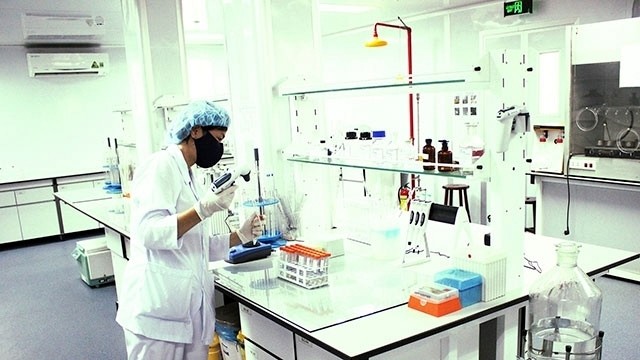The "made in Vietnam" imprint
Vietnam so far has had to rely on foreign manufacturers for the supply of influenza vaccines. The best way to ensure access to these human lifesaving tools is to produce vaccines constantly and always be ready for pandemic response.
Witnessing the achievements after much hardship, Dr. Le Van Be, former Head of the Institute of Vaccines and Medical Biologicals (IVAC), confidently affirmed that this is a resounding success in research cooperation between IVAC and international organisations, such as the World Health Organisation (WHO), the global health organisation PATH and the Biomedical Advanced Research and Development Authority (BARDA).
The success has been also praised by the world, recognising the prestige and intelligence of the Vietnamese medical sector. It not only brings great benefits to public healthcare but will also supply vaccines to the world in the near future.
The haunting number always reminds the members of the Vietnamese research team that there are 650,000 deaths and about 3-5 million cases of severe seasonal flu worldwide each year. The recent major influenza pandemic, which had a major impact on Vietnam, is the 2009 A/H1N1 that lasted for 12 months and claimed the lives of more than 284,000 people worldwide, of which 78,000 died in Southeast Asia. Dr. Le Van Be often encourages his colleagues that the desire to protect the health of others and to write the name of the Vietnamese medical sector in the world will help erase all hardship, and 2019 is a special time, which is full of positive energy.
During the clinical trial, the above vaccines were found to be safe and capable of providing a protective immune response in healthy adults. The test was evaluated by world scientists as a long step forward for the Vietnam medical sector.
Rivals to the epidemic
Having a burning desire to promote the capacity of vaccine development in Vietnam, Dr. Nguyen Tuyet Nga, acting head of PATH Mekong Regional Programme, said: “The outbreak of infectious diseases threats to our health, but also quickly adversely affects a nation's growth and development. Therefore, ensuring global health security is a big priority for PATH. I welcome and really admire the two types of vaccines that Vietnam has made. Hopefully, in this spring, the vaccine will be produced on a large scale, contributing to stopping pandemics when they occur.”
Looking at the research labs always busy in testing vaccines like a race against time, IVAC Head Dr. Duong Huu Thai shared with happiness: “When we started the project, everyone only had a sole desire to try their best for the health of the people and for a product that carries a Vietnamese brand. The research process has gone through many hardships, with both domestic and foreign testing. The WHO, the Ministry of Health and Ministry of Science and Technology have rated this success at an excellent level. It is a national project with great social significance. With our current capacity, IVAC can produce three million doses per year.”
 |
Modern machinery system for vaccine production in line with international standards. (Photo: NDO/Ha Van Dao)
The most difficult process in the journey to conquer the against-pandemic product lasting for nearly 10 years is to find the source of raw chicken eggs and chicken embryos to produce vaccines. Not to recede against failures, the project members eventually selected the Novo White chicken breed from France, with both the weight and health of this chicken suitable for vaccine production. They were all imported and cared for in a special regime, and their eggs with embryos are used for research.
According to Dr. Thai, this is an innovative choice, suitable to the technical and economic conditions of Vietnam and IVAC. This technology is internationally recognised and can be produced on a large scale. Each year, a Novo White chicken lays about 300 eggs, which are controlled for all abnormalities from the beginning. After 11-day hatch, the viruses are injected into the chicken embryos for vaccine production. The eggs must then be incubated for three more days to let the virus multiply and develop. Then the buffer material with a high viral density will be extracted to put into the new process of filtering, separating and refining into the influenza antigen to produce vaccines. Every stage of the production process must comply with an exactly, scientific manner, as any errors will affect the vaccine quality.
Confidence with Vietnamese intelligence
According to an assessment from PATH and the world leading medical experts, successful and marketable IVACFLU-S and IVACFLU-A/H5N1 vaccines are significant advances in the production of sustainable influenza vaccines, establishing Vietnam's position as a pioneer in vaccine development and production among low and middle income countries.
As the world's flu vaccine development and production sources are concentrated in a limited number of countries and global production currently does not meet the demand, many low and middle income countries are being barred from reaching the vaccine supply. So the participation of flu vaccine providers like IVAC is very important to sustainably address this deficiency and affirm Vietnam's intelligence to the world.
Witnessing the process and efforts in the production of IVACFLU-S and IVACFLU-A/H5N1 vaccines in Vietnam, scientist Guido Torelli from WHO affirmed that the two products have helped firmly establish Vietnam’s position, while demonstrating a significant contribution from Vietnam to the health of mankind.
















